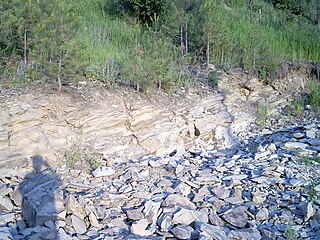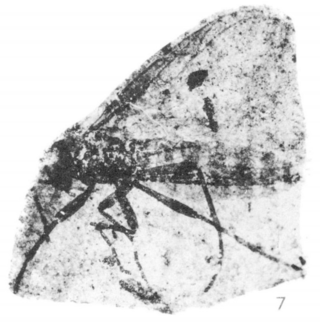Driftwood Canyon Provincial Park is a provincial park in British Columbia, Canada. Driftwood Canyon Provincial Park covers 23 ha of the Bulkley River Valley, on the east side of Driftwood Creek, a tributary of the Bulkley River, 10 km northeast of the town of Smithers. The park is accessible from Driftwood Road from Provincial Highway 16. It was created in 1967 by the donation of the land by the late Gordon Harvey (1913–1976) to protect fossil beds on the east side of Driftwood Creek. The beds were discovered around the beginning of the 20th century. The park lands are part of the asserted traditional territory of the Wet'suwet'en First Nation.

Azolla primaeva is an extinct species of "water fern" in the family Salviniaceae known from Eocene fossils from the Ypresian stage, found in southern British Columbia.
Wessiea is an extinct morphogenus of fern not placed in a specific family. Wessiea is known from Late Cretaceous and Middle Miocene age fossils found in Central Washington USA and Southern Alberta Canada. Two species are described in the morphogenus, W. oroszii and the type species W. yakimaensis.

The Princeton Chert is a fossil locality in British Columbia, Canada, which comprises an anatomically preserved flora of Eocene Epoch age, with rich species abundance and diversity. It is located in exposures of the Allenby Formation on the east bank of the Similkameen River, 8.5 km (5.3 mi) south of the town of Princeton, British Columbia.

The McAbee Fossil Beds is a Heritage Site that protects an Eocene Epoch fossil locality east of Cache Creek, British Columbia, Canada, just north of and visible from Provincial Highway 97 / the Trans-Canada Highway. The McAbee Fossil Beds, comprising 548.23 hectares, were officially designated a Provincial Heritage Site under British Columbia's Heritage Conservation Act on July 19, 2012. The site is part of an old lake bed which was deposited about 52 million years ago and is internationally recognised for the diversity of plant, insect, and fish fossils found there. Similar fossil beds in Eocene lake sediments, also known for their well preserved plant, insect and fish fossils, are found at Driftwood Canyon Provincial Park near Smithers in northern British Columbia, on the Horsefly River near Quesnel in central British Columbia, and at Republic in Washington, United States. The Princeton Chert fossil beds in southern British Columbia are also Eocene, but primarily preserve an aquatic plant community. A 2016 review of the early Eocene fossil sites from the interior of British Columbia discusses the history of paleobotanical research at McAbee, the Princeton Chert, Driftwood Canyon, and related Eocene fossil sites such as at Republic.

The Allenby formation is a sedimentary rock formation in British Columbia which was deposited during the Ypresian stage of the Early Eocene. It consists of conglomerates, sandstones with interbedded shales and coal. The shales contain an abundance of insect, fish and plant fossils known from 1877 and onward, while the Princeton Chert was first indented in the 1950's and is known from anatomically preserved plants.

Nuphar carlquistii is an extinct species of flowering plant in the family Nymphaeaceae related to the modern spatterdock, Nuphar advena. The species is known from fossil seeds and fruits found in the early Eocene Okanagan Highlands deposits of northern Washington state and British Columbia, Canada.

Comptonia columbiana is an extinct species of sweet fern in the flowering plant family Myricaceae. The species is known from fossil leaves found in the early Eocene deposits of central to southern British Columbia, Canada, plus northern Washington state, United States, and, tentatively, the late Eocene of Southern Idaho and Earliest Oligocene of Oregon, United States.

Amia? hesperia is an extinct species of bony fish in the bowfin family, Amiidae. The species is known from fossils found in the early Eocene deposits of northern Washington state in the United States and southeastern British Columbia. The species is one of eight fish species identified in the Eocene Okanagan Highlands paleofauna.

Equisetum similkamense is an extinct horsetail species in the family Equisetaceae described from a group of whole plant fossils including rhizomes, stems, and leaves. The species is known from Ypresian sediments exposed in British Columbia, Canada. It is one of several extinct species placed in the living genus Equisetum.
The paleoflora of the Eocene Okanagan Highlands includes all plant and fungi fossils preserved in the Eocene Okanagan Highlands Lagerstätten. The highlands are a series of Early Eocene geological formations which span an 1,000 km (620 mi) transect of British Columbia, Canada and Washington state, United States and are known for the diverse and detailed plant fossils which represent an upland temperate ecosystem immediately after the Paleocene-Eocene thermal maximum, and before the increased cooling of the middle and late Eocene to Oligocene. The fossiliferous deposits of the region were noted as early as 1873, with small amounts of systematic work happening in the 1880-90s on British Columbian sites, and 1920-30s for Washington sites. A returned focus and more detailed descriptive work on the Okanagan Highlands sites revived in the 1970's. The noted richness of agricultural plant families in Republic and Princeton floras resulted in the term "Eocene orchards" being used for the paleofloras.

The Eocene Okanagan Highlands or Eocene Okanogan Highlands are a series of Early Eocene geological formations which span a 1,000 km (620 mi) transect of British Columbia, Canada, and Washington state, United States. Known for a highly diverse and detailed plant and animal paleobiota the paleolake beds as a whole are considered one of the great Canadian Lagerstätten. The paleobiota represented are of an upland subtropical to temperate ecosystem series immediately after the Paleocene–Eocene thermal maximum, and before the increased cooling of the middle and late Eocene to Oligocene. The fossiliferous deposits of the region were noted as early as 1873, with small amounts of systematic work happening in the 1870–1920s on British Columbian sites, and 1920–1930s for Washington sites. Focus and more detailed descriptive work on the Okanagan Highland sites started in the late 1960s.
The paleofauna of the Eocene Okanagan Highlands consists of Early Eocene arthropods, vertebrates, plus rare nematodes and molluscs found in geological formations of the northwestern North American Eocene Okanagan Highlands. The highlands lake bed series' as a whole are considered one of the great Canadian Lagerstätten. The paleofauna represents that of a late Ypresian upland temperate ecosystem immediately after the Paleocene-Eocene thermal maximum, and before the increased cooling of the middle and late Eocene to Oligocene. The fossiliferous deposits of the region were noted as early as 1873, with small amounts of systematic work happening in the 1880-90s on British Columbian sites, and 1920-30s for Washington sites. Focus and more detailed descriptive work on the Okanagan Highlands site started in the last 1970's. Most of the highlands sites are preserved as compression-impression fossils in "shales", but also includes a rare permineralized biota and an amber biota.
Uhlia is an extinct genus of coryphoid palm containing a single species Uhlia allenbyensis. The species is known from permineralized remains recovered from the Princeton Chert in British Columbia, Canada. Leaves of Uhlia have "tar spot"-like fungal infections of the extinct ascomycete Paleoserenomyces, which in turn are hyperparasitized by the ascomycete Cryptodidymosphaerites.
Paleoserenomyces is an extinct monotypic genus of pleosporale fungus of uncertain family placement. When described it contained the single species Paleoserenomyces allenbyensis. The genus is solely known from the Early Eocene, Ypresian aged, Princeton Chert deposit of the Allenby Formation. Palaeoserenomyces is one of only three described fossil fungus species found in the Princeton Chert, being a tar spot like parasite of the fossil palm Uhlia allenbyensis, and is host for the hyperparasite Cryptodidymosphaerites princetonensis.
Cryptodidymosphaerites is an extinct monotypic genus of pleosporale fungus of uncertain family placement. When described it contained the single species Cryptodidymosphaerites princetonensis. The genus is solely known from the Early Eocene, Ypresian aged, Princeton Chert deposit of the Allenby Formation. Cryptodidymosphaerites is one of only three described fossil fungus species found in the Princeton Chert, and is a hyperparasite of Palaeoserenomyces allenbyensis, itself a tar spot-like parasite of the fossil palm Uhlia.

Plecia avus is an extinct species of Plecia in the March fly family Bibionidae and is solely known from Early Eocene sediments exposed in central southern British Columbia. The species is one of twenty bibionid species described from the Eocene Okanagan Highlands.
The Paleobiota of the Klondike Mountain Formation comprises a diverse suite of Early Eocene plants and animals recovered from North Central Washington State. The formation outcrops in locations across the north western area of Ferry County, with major sites in Republic, north west of Curlew Lake, and on the Toroda Creek area. The formation is the southern most of the Eocene Okanagan Highlands, sharing much of the paleoflora and paleofauna with site across Central and southern British Columbia.

Dennstaedtia christophelii is an extinct species of fern in the family Dennstaedtiaceae related to the modern hayscented ferns. The species is known from fossil fronds found in early Eocene sites of northern Washington state, United States and central British Columbia, Canada. The species is suggested to be closest to a Neotropical "Patania" clade and specifically the species Dennstaedtia producta and Dennstaedtia mathewsii.
Allenbya is an extinct genus of water lilies in the family Nymphaeaceae containing a single species Allenbya collinsonae. The species is known from permineralized remains recovered from the Early Eocene Princeton Chert in British Columbia, Canada.











